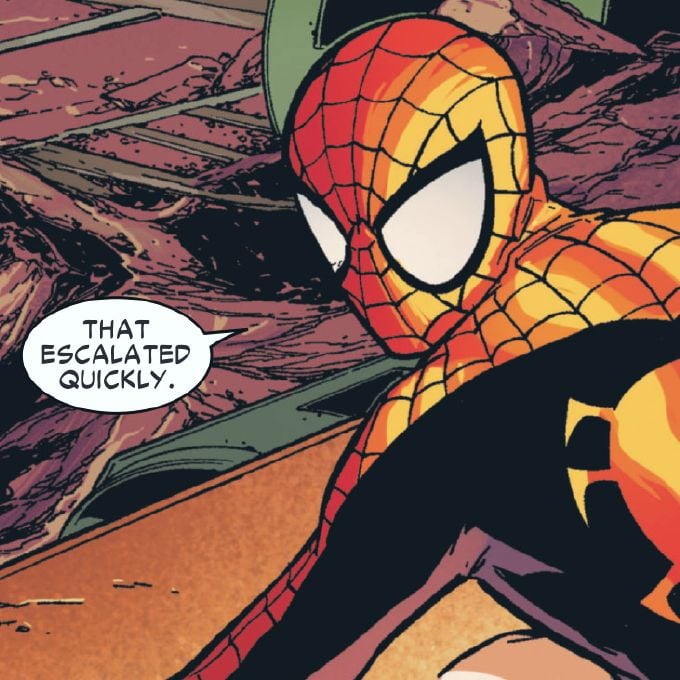Even with single people in cars you can move wayyyy more than 100 people per hour in the top left.
Assume 25 mph speed and 30 feet between cars, each car crosses 30 feet in about a second. 3600 seconds in an hour, times 2 for both directions and you have 7200 people that can move on that little road.
Now add additional passengers…buses…it can move a decent amount more. There’s lots of reasons cars suck but let’s not make up math to prove the point.
It’s not saying that the top row can support at most 100 people.
Just that if you have 100 people per hour, you need something like what’s in the picture. The train tracks aren’t being fully utilized in the top pic, either.
As an aside, you’re forgetting that cars are ~15 feet long on average. So you’ve got an hour of traffic with consistently 1 car following distance, which is fairly unrealistic. Real world capacy of a lane is closer to 2k people per hour, or 4k both directions.
Yeah and the big road below can hold WAY more than 10,000 too. The numbers here are all made up and it doesn’t really do a good job of making the point the creator wants to make.
Yeah.
I think I count 23 lanes in the bottom pic.
Ignoring the effect of heavy vehicles and assuming a free flow speed of 70, the federal highway authority’s numbers would be 2400 vehicles per lane or 55k vehicles per hour. Assuming an average occupancy of 1.5 people per vehicle, that’s nearly 83k.
I’m having trouble finding actual sources right now for max rail capacity, but https://en.m.wikipedia.org/wiki/Passengers_per_hour_per_direction claims 60-90k passengers per direction on 3.5 meter lanes for “suburban rail”.
Although 83k people per hour is 41.5k people per rail track. Assuming a 360 person train like the Bombardier BiLevel Coach, that’s only 115 train cars per hour per track. If each train has 11 cars, that’s 10 trains per hour or a train every 6 min. Not really that unreasonable, and the tracks will look mostly empty unlike that monstrosity of a road.
The road in the bottom picture seems to be jammed. 23 lanes are no use if there’s a bottleneck at the end.
That’s by design, and helps make the case for MOAR FREEWAY$$!
That photo looks like the 26-lane wide Katy Freeway in Houston! I use the rule of thumb of 2000 pphpd (passengers per hour in peak direction) for a fully-loaded freeway lane from this much better-looking graphic we saw last time we discussed this question on lemmy. (Apparently this graphic is now the headliner on the pphpd wiki page!)
2000 pphpd per lane matches my own attempts to verify this value. I couldn’t find traffic stats for Katy Freeway, but here are the stats for Manhattan river crossings: https://www.nyc.gov/html/dot/downloads/pdf/manhattan-river-crossings-2016.pdf Specifically, the George Washington Bridge is a very busy bridge with 7 lanes in each direction and highly-optimized traffic density - constant traffic flow with no spacing in between - a good example of peak highway lane capacity IMO. It moves 290k vehicles per day, but more importantly 11k incoming vehicles during peak morning rush hour (page 10), which is 1600 vehicles per lane. The average occupancy is 1.74 (page 24, though not sure how that treats buses), so that’s 2800 ppphd per lane.
GWB does have a lot of truck traffic though. The Holland Tunnel has 2 lanes in each direction, no trucks, constant traffic flow with no spacing, 2700 inbound vehicles during peak morning rush hour (page 10), and 1.22 occupancy (page 24), resulting in 1600 pphpd per lane.
So that’s
2739*1.22 + 4860*1.41 + 11474*1.74= 30k people crossing from New Jersey into Manhattan during the morning rush hour using the 2+4+7=12 lanes of the Holland+Lincoln tunnels and GWB or 2500 pphpd per lane. I believe that sufficiently approximates 13 lanes of Katy Freeway, which has no trucks and no buses.Compare that to the 22k people transported from New Jersey into Manhattan during morning peak rush hour by PATH trains in two incoming tubes (https://www.panynj.gov/content/dam/path/about/statistics/2023-PATH-Hourly-Ridership-Report.pdf page 14, only shows turnstyle entries but almost everyone entering is travelling to Manhattan). And PATH trains look outright empty compared to crowd crush on NYC trains. Lexington Avenue Subway is like 32k pphpd for a single express track (https://new.mta.info/document/22126 page 5B-4,
25*1296in 2002 and has gone higher since).In conclusion, the numbers in this meme photo do not reflect full capacity, thus leading to questions and confusion, but the overall comparison is still valid: one half of a 26 lane highway has about the same capacity of ~30k pphpd for peak hour travel as one half of a 2-track railway.
when r u gonna build a traintrack outside my house plz and thank u
if u dont build a traintrack to every single house itd be a waste of time due to current scales of infrastructure.
At 25mph, the safe distance between cars is closer to 60-70 feet. Add the length of the cars for another 15-20 feet and your throughput calculations drop by a factor of 2.5-3 already.
It gets worse once you start considering comparable velocities. Trains go way over 25mph.
Also assume that no one is turning onto or off of the road?
Theoretically the highway I can see outside my window could handle tens of thousands of passengers per hour moving at over 60mph. But for some odd reason when I look out my window on workday it’s moving significantly less than 25 mph. Some days is not even moving at all.
Yeah but for long term growth is not ideal, the tracks will do a better job in long run.
No matter the math, trains move more people, faster and safely. What you should use for your argument is that it’s easier and better to low capacity roads in rural areas (low population) than building trains to replace the car everywhere. Either way there is no argument against trains from city to city or a metro. Cars get out competed there.
I don’t disagree, but we shouldn’t be pulling numbers out of our asses that are orders of magnitude different from the real figures.
Quick search gave this number:
Theoretical maximum saturation flow rate per lane (this will allow you to do quick calculations in your head to check reasonableness at big events): 1,900 vehicles per hour per lane
So the bottom would probably be more like 25K each way. Lightrail is only about 4-8k? Meanwhile a single subway lane each way could do more than that thing on the bottom left.
I’m guessing you found this source: https://www.mikeontraffic.com/numbers-every-traffic-engineer-should-know/
The number from that page he should actually be using is more like this one:
Planning level daily capacity of a road (Round numbers based on Level of Service D/E thresholds in HCM 6th Edition)
- 2 lane (w/ left turn lanes): 18,300 vehicles per day
(Source: I’m a former traffic engineer.)
Yup.
What does “should” mean in this context? Wouldn’t it depend on if you are trying to compare peak capacities or daily usages? I’d assume which one matters more would vary based on why you are comparing them in the first place?
I really wish I could use those roads for transport using a bicycle. I just don’t feel like being passed by a truck moving at 80km/h just a few centimeters away in a curve with bad visibility, potentially even with fog in the morning.
You can make multiple extra lanes for cars, but not a single lane for bicycles?
TBH, where I live, those 80km/h roads aren’t as bad as you would think. Cars slow down before bends because they anticipate that a bicycle, hiker, tractor or whatever slow moving vehicle and usually pass them with decent space.
But that is only true for less frequented roads, if there is heavy oncoming traffic and save overtaking is not possible, people will still try to squeeze through and there separated bike lanes are really important.
You’re making the right point, BUT pretty much every train service provider would add more parallel tracks if they increase the number of trains to a certain point, because they start getting in the way of each other
Well except in Germany
Cries in additional Hamburg-Hanover track 😭
Fucking NIMBY’s doing fucking NIMBY things.
It’s so disappointing to see all this construction finally happening in your town and then there’s just two tracks without even space for more. No express service, the train takes just as long as the freeway, even in rush hour, or longer if you have to transfer.
As always, the problem with commuter trains is the last mile. If you work in the city, there is probably some form of bus or subway, but if you work in an unwalkable suburb, you’ll need an Uber for that last mile which cuts into the benefit.
We shouldn’t be building unwalkable suburbs
We already did.
And continue to do so, that is what should get stopped.
So we should continue catering to their needs, thereby encouraging the construction of more unwalkable suburbs?
There are a lot of things we shouldn’t do that we already did.
that’s not a problem with trains it’s a problem with unsustainable land use
Yeah lol
“Nobody builds suburbs you can walk in without rolling an ankle or getting hit by a car” “Yeah man that’s the fucking trains fault”
Agreed, but it still an obstacle to wider adoption of trains.
@themeatbridge @sexy_peach Commuter driving has the same ‘last mile’ problem, but it’s parking.
The photo doesn’t include the $250 million worth of carparks for those 10,000 cars that has to exist at the other end of the highway.
I agree with you, but employers are solving that problem by leaving densely developed places for suburban and rural locations. This contributes to sprawl and compounds the complexity of the problem. All because public transit can’t solve the last mile problem.
We need adaptive infrastructure and regulated development to coincide with public transit, but at least in the USA, I might as well be talking about flying to Mars on unicorn farts.
Regulatory capture isn’t just a thing that happens, it’s the very foundation of our political system. Like a house grown from fungus, it’s not “corrupted” because the corruption is all there is.
The problem is the unwalkable suburb that doesn’t make any sense. It never made sense either.
It’s not only bad for commuting. It’s a mess for groundwater, pollution of all type (noise, microplastics, air, etc.) It has an impact on the wildlife including reproduction, on plants, etc.
It’s just a bad use of space? No, it’s bad socially by isolating people. It creates urban traps. I will stop here otherwise I will continue on the fact it’s a myth created by the capital…
surely you can bike 2 miles in the burbs? One of the upsides of suburbs being so painfully sprawly is that barely anyone lives there, so you shouldn’t have a tremendous amount of traffic on those 2 miles to the train station.
And even if you’d fear for your life biking there now, it’s not like you need to build bike paths along every little residential street to fix it, start with the largest most high-traffic roads and build your way down until people feel safe biking to the train station.
Sure, but then you have to carry your bike with you on the train. There is no workable solution to suburbia that doesn’t involve cars because it was designed and built around them. Unfortunately, they’re now home to tens of millions of people, and any quick solution would most likely end up hurting a lot of them.
Bike parking at the train stations. You bike to the train station, lock the bike up, take the train, take the second bike from the destination train station, bike to the office. See videos on how the Dutch do it. Even with multiple bikes it’s incredibly cheap in terms of money as well as climate impact compared to even the cheapest cars.
Lol you could easily buy matching ebikes for less than the price of a half way reliable car these days
just park the bike???
y’all keep inventing problems that don’t exist.
Actually, you can leave a bike at the bike garage near the station or rent one on a monthly basis. That’s what they do in Japan.
does not work in the US. bike theft is too easy.
They have cameras and a guard and you lock it up. Not the problem you think it is.
Well, in the Netherlands and at least some other EU countries most train stations have a bike rental system that works by just using a card to unlock the bike for a couple of Euros for 24 hours. So there is a possible solution.
Many people here use that system. It’s also possible to buy a (second-hand) bike and park it at the station where you need it, if you’d like.
Edit: Didn’t see the post below… but exactly that.
I agree carrying the bike on the train is a problem, but there are a solutions like e-scooters and bikeshare.
not quite, suburbs are more dangerous for bikes because cars are used to wide smooth roads and do not look for bikes.
Or just have a parking lot/garage, or bike the last mile…
My nearest bus stop is four miles away and I would definitely die if I tried to ride a bike there. These roads are crazy dangerous.
The whole point of this sub is advocating for changing that and getting rid of car centric development.
Right, but it’s like a support group for depression that provides advice like “have you tried not being sad?”
You can’t fix car-centric development by pointing out all the ways in which the world would be better if everything were different. You need to have a plan, a pathway from point A to point B, and point B needs to be accessible from point A. Anything less is just ineffectual whining.
An easy improvement would be protected bike lanes along those roads
To be sure, that would be a quality of life improvement, but it wouldn’t actually solve the problem where I live. It’s too hilly and we have too many rainy and snowy days to reliably commute via bike. I love the nearby bike trails, and my neighborhood is great for taking the kids for a ride. But a two hour ride over a mountain for a 9 AM office meeting is a non-starter.
Okay, maybe it won’t help you, but there sure are people who don’t commute 30+km each way and could use some part of the bike lane. Also, ebikes exist
Weather and hills really are not the main issue, I live in Switzerland. We have plenty of hills and shitty weather ;)
dude if people can find the money for cars they can absolutely find the money for an e-bike. the “but hills” argument died like at least 5 if not 10+ years ago.
Where I live, the train station is smack in the middle of all the big employers!!
There just isn’t actual service to the station…
Why did it become unwalkable?
I think, eventually, this is where autonomous vehicles will really come into their own.
You are absolutely right that first mile/last mile is a barrier for rail travel - but imagine if we could design the station around a fleet of AV’s.Imagine:
Your AV takes you to the station, and parks right next the platform at the exact location along the train for your seat reservation.
You wait in your nice climate controlled AV for the train to arrive - hope out and onto the train.Meanwhile somebody else gets off the train and uses the AV you’ve just vacated to complete their journey.
May I introduce you to the mind blowing concept of buses?
These things all complement each other. Busses are great in urban areas, but they don’t work well in rural areas, they just don’t compare well vs private car when you look at generalized journey times (GJT).
Buses are also great in rural areas. If the too few people take the bus, a small parking lot in the front of the station may actually be fine and people can ride their bikes or maybe small electric cars there. No need for AV techbro shit
but why on god’s green earth would you spend the money on autotaxis rather than buses and/or bike infrastructure?
All these things should work on harmony. In some situations busses and bikes don’t work as well. Let’s say you are going on holiday with luggage.
The end game is to reduce the the reliance on personal cars. Right now most people feel they need their own car. Much of this is down to first mile / last mile arguments.
Long headways, and high friction interchanges are things AVs could potentially help to eliminate one day. I would actively encourage consideration of multiple pickup and drop off by those AVs - key is we probably want to get people to their doors and we need high frequencies, or ad-hoc departure times to complete with car.
Oh interesting. I like this idea way more than AVs being the entirety of the trip.
Yes, exactly, this would solve the last mile problem and solve the AV problem with long-distance trips. To get there, though, you might need to make certain areas exclusively accessible via autonomous vehicles. For instance, make certain cities AV only, and free up some road space for walking and biking.
But I recognize that this is about as likely as getting everyone to stop turning green space into parking lots.
Remember when Robert Moses intentionally made the parkways hostile to buses and trains? There’s a bit in The Power Broker about how his engineers wanted to put trains in, or at least build the roads so it would be easy to do later. Moses said no.
We should consider comfort for the passengers though. Too often people only think of how many people can fit, they don’t think if those same people should fit though.
A train ride will always be more comfortable than being stuck in traffic.
Have you ever ridden in an overcrowded Indian train?
Yeah, some parts of the world, overcrowded trains are a huge problem.
I used to ride commuter rail in Boston. 363 days out of the year it wouldn’t be terribly crowded. Maybe standing-room-only for the first couple stops during rush hour.
But those other two days…that’s when the pats and the Sox have their victory parades. May god have mercy on the souls of regular commuters who aren’t sports fans.
The toilets in some Indian trains is a trip within themselves too. At least, in the one I took to northern India, so perhaps more rural.
Anyway, it was a literal hole in the floor of the train with bare tracks whizzing by your ass. Gotta say, that was an adventure I hadn’t thought about in a long time.
Yes, you are defecating on the train tracks. Along those same tracks, some people were living their lives in little huts made from trash. Speaks for itself.
This was around 2008, I hope something improved, it broke my heart.
Not even that extreme, just an overcrowded train with someone who smells or is drunk is way worse than being in traffic. For plenty of women, someone who looks threatening can make a trip mega uncomfortable.
First class is like 10€ extra and you can get buzzed and served food where you sit.
The seats are not as comfortable. Wearing ear buds is not as comfortable, crowds or standing, not being in a private space, carrying everything and keeping track of it against thieves, Also, this fantasy train goes directly to your workplace? I don’t know I think there will be some disagreement even from people who like trains. Quicker commute is important.
No.
Yes.
I’m not standing like a sardine with smelly people touching me on all sides. Trains should be clean with seating or some semblance of personal space available, otherwise it means the train operator underestimated the number of transit users and cannot ensure the comfort of its users.
No fuck you car bad, unga dunga. Seriously though I appreciate the nuance here, public transportation still needs to be comfortable without cramming people in like cattle
That’s a valid point, which is keeping some people from using public transit, wether we like it or not.
Some rail providers require you to reserve a seat when booking a ticket (French TGV, maybe?).
And another perspective: We might consider comfort for non-passengers, too. I’d rather cross a few tracks than a highway.
Well, lot of cars have just 1 passenger in it …
That’s the point. They’re such a huge waste of space and energy, it’s not even funny.
i always “enjoy” stopping for a moment and counting the number of cars on a stretch of road and comparing it to the number of people i see outside of a vehicle.
Most of the time they’re about equal, and yet the roads are so full from that piddly amount that people have to stop at give-way intersections and wait for up to a minute at a time, while the worst the multi-use paths ever get is people having to step to the side a bit.
Jfc what road is that on the left?
Narrowest road in America
Texas, I think.
It could be a part of i10 in houston, but it looks like it might be a lane or two more each way.
Depends on where in the world you are too. See the video for a example. https://www.youtube.com/watch?v=3Hge8FyrZ5A
So yeah, you numbers might vary but the point is correct.

















